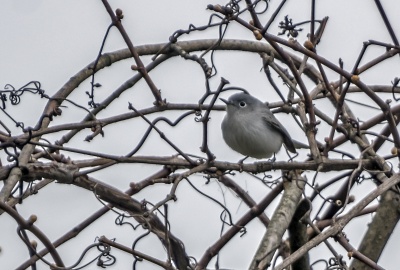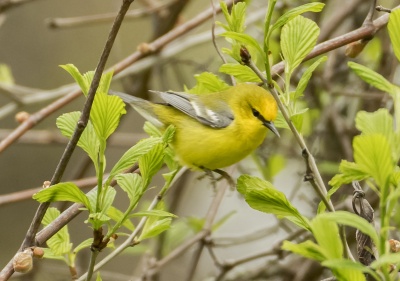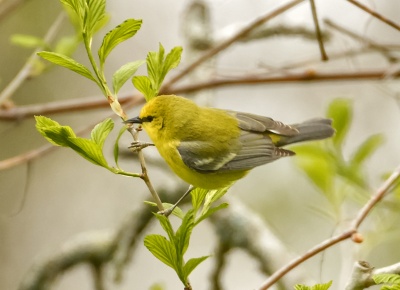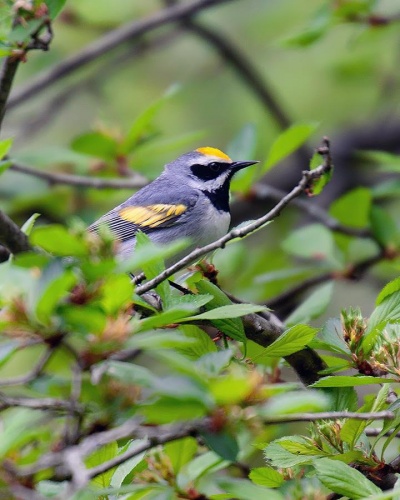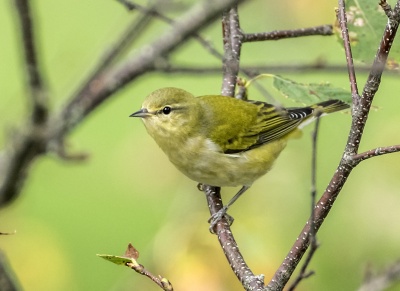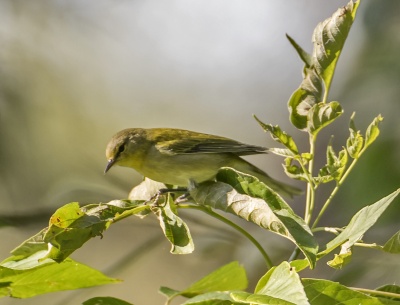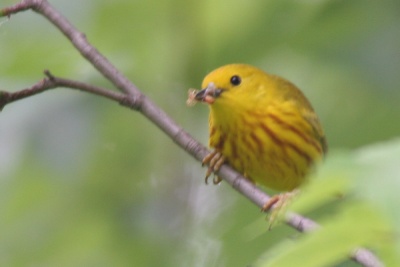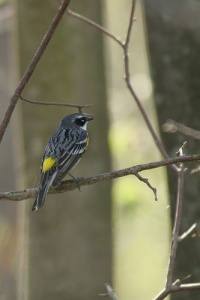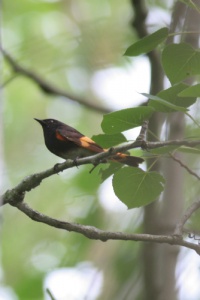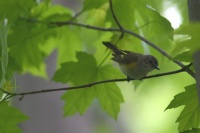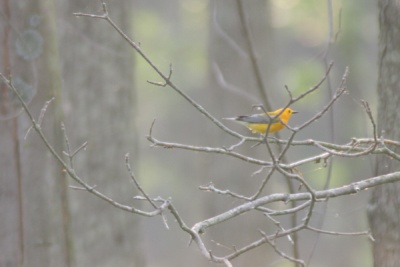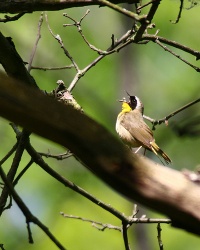Warblers
|
|
Contents
- 1 Old World Warblers
- 2 Wood Warblers
- 2.1 Blue-Winged Warbler
- 2.2 Golden-Winged Warbler
- 2.3 Tennessee Warbler
- 2.4 Orange-Crowned Warbler
- 2.5 Nashville Warbler
- 2.6 Yellow Warbler
- 2.7 Chestnut-Sided Warbler
- 2.8 Magnolia Warbler
- 2.9 Cape May Warbler
- 2.10 Black-Throated Green Warbler
- 2.11 Yellow-rumped Warbler
- 2.12 Black-Throated Blue Warbler
- 2.13 Blackburnian Warbler
- 2.14 Pine Warbler
- 2.15 Palm Warbler
- 2.16 Bay-Breasted Warbler
- 2.17 Blackpoll Warbler
- 2.18 Cerulean Warbler
- 2.19 Black-And-White Warbler
- 2.20 American Redstart
- 2.21 Prothonotary Warbler
- 2.22 Ovenbird
- 2.23 Northern Waterthrush
- 2.24 Mourning Warbler
- 2.25 Common Yellowthroat
- 2.26 Hooded Warbler
- 2.27 Wilson's Warbler
- 2.28 Canada Warbler
- 2.29 Yellow-Breasted Chat
Old World Warblers
Blue-Gray Gnatcatcher
(Polioptila caerulea)
COMMON: Breeds in the region, found in favored habitat at a number of local birding sites. Blue-gray Gnatcatchers are tiny, slim songbirds with long legs; a long tail; and a thin, straight bill.
Blue-gray Gnatcatchers are pale blue-gray birds with grayish-white underparts and a mostly black tail with white edges. The underside of the tail is mostly white. The face is highlighted by a thin but obvious white eyering. In summer, male Blue-gray Gnatcatchers sport a black ‘V’ on their foreheads extending above their eyes.
The energetic Blue-gray Gnatchatcher rarely slows down, fluttering after small insects among shrubs and trees with its tail cocked at a jaunty angle. Blue-gray Gnatcatchers often take food from spiderwebs and also abscond with strands of webbing for their tiny nests, which are shaped like tree knots.
In the East, gnatcatchers breed in deciduous forests and near edges, often in moister areas. In the West, look for them in shorter woodlands and shrublands including pinyon-juniper and oak woodlands.
Wood Warblers
Blue-Winged Warbler
(Vermivora pinus)
COMMON: Breeds in the Western New York Region and have been located in several local birding sites. Blue-winged Warblers are small, well-proportioned birds with a sharp and pointed bill. Compared to other warblers, the rather heavy black bill and eyeline give them a pointy-headed look.
Adult males are bright yellow below, yellow-green above, and have two obvious wingbars on blue-gray wings, and a black eyeline. Adult females are paler with a less defined eyeline. The black bill and eyeline contribute to an almost angry-looking expression. From below look for the white undertail coverts on both sexes.
These warblers dangle from shrubs much like a chickadee, often foraging upside down and picking insects from dead leaves. Males sing from exposed perches during the breeding season. They join mixed-species flocks during migration and on the wintering grounds, but perhaps less frequently than Golden-winged Warblers.
Blue-winged Warbler is a shrubland specialist, and are found in brushy fields, thickets, and forest edges.
Golden-Winged Warbler
(Vermivora chrysoptera)
RARE: A boldly marked warbler with a color pattern all its own, Golden-winged Warblers are slim, silvery gray birds with golden flashes on the head and wings. They breed in wet, shrubby tangles of the Upper Midwest and Appalachians, and spend winters in open woodlands and shade-coffee plantations. They have suffered severe population declines in the last half-century. They often hybridize with Blue-winged Warblers, producing a range of distinctive forms. NO LOCAL PHOTOS AVAILABLE AT THIS TIME
Tennessee Warbler
(Vermivora peregrina)
COMMON: Migrates through Western New York, Commonly found in mixed flocks of feeding warblers during the spring and fall migrations. Small and stocky for a warbler, with a short tail and a thin and sharply pointed bill (markedly smaller and more pointed than a Red-eyed Vireo's bill).
Breeding males have a gray head with a white line over the eye, contrasting with a green back and no wingbars. The underparts are whitish all the way through the undertail coverts. Females and nonbreeding males are more greenish, with less contrast between head and back. Occasionally very olive-yellow all over except for white undertail coverts.
Tennessee Warblers forage on slender branches high in the forest canopy, feeding primarily on insects. On their breeding grounds a primary food is a small caterpillar called spruce budworm.
Tennessee Warblers breed in coniferous or mixed deciduous-coniferous forest across Canada. On migration they can occur in most types of forests and woodlands. Winters in second-growth tropical forests.
Orange-Crowned Warbler
(Vermivora celata)
Nashville Warbler
(Vermivora ruficapilla)
Yellow Warbler
(Dendroica petechia)
Chestnut-Sided Warbler
(Dendroica pensylvanica)
Magnolia Warbler
(Dendroica magnolia)
Cape May Warbler
(Dendroica tigrina)
Black-Throated Green Warbler
(Dendroica virens)
Yellow-rumped Warbler
(Dendroica coronata)
Black-Throated Blue Warbler
(Dendroica caerulescens)
Blackburnian Warbler
(Dendroica fusca)
Pine Warbler
(Dendroica pinus)
Palm Warbler
(Dendroica palmarum)
Bay-Breasted Warbler
(Dendroica castanea)
Blackpoll Warbler
(Dendroica striata)
Cerulean Warbler
(Dendroica cerulea)
Black-And-White Warbler
(Mniotilta varia)
American Redstart
(Setophaga ruticilla)
Prothonotary Warbler
(Protonataria citrea)
Ovenbird
(Seiurus aurocapillus)
Northern Waterthrush
(Seiurus noveboracensis)
Mourning Warbler
(Oporornis philadelphia)
Common Yellowthroat
(Geothlypis trichas)
Hooded Warbler
(Wilsonia citrina)
Wilson's Warbler
(Wilsonia pusilla)
Canada Warbler
(Wilsonia canadensis)
Yellow-Breasted Chat
(Icteria virens)
